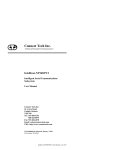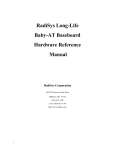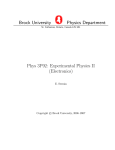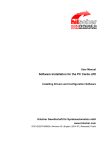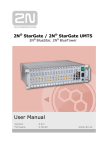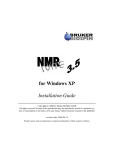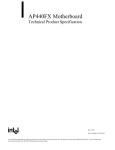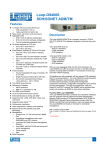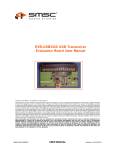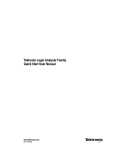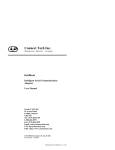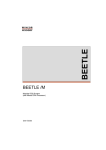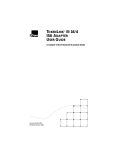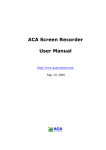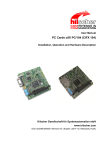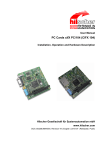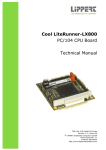Download User Manual - Connect Tech Inc.
Transcript
Intellicon NT960 Intelligent Serial Communications Subsystem User Manual Connect Tech Inc 42 Arrow Road Guelph, Ontario N1K 1S6 Tel: 519-836-1291 Toll: 800-426-8979 (North America only) Fax: 519-836-4878 Email: [email protected] [email protected] URL: www.connecttech.com CTIM-00091, Revision 1.13, November 2004 Connect Tech Intellicon NT960 User’s Manual Limited Lifetime Warranty Connect Tech Inc. provides a Lifetime Warranty for all Connect Tech Inc. products. Should this product, in Connect Tech Inc.'s opinion, fail to be in good working order during the warranty period, Connect Tech Inc. will, at its option, repair or replace this product at no charge, provided that the product has not been subjected to abuse, misuse, accident, disaster or non Connect Tech Inc. authorized modification or repair. You may obtain warranty service by delivering this product to an authorized Connect Tech Inc. business partner or to Connect Tech Inc. along with proof of purchase. Product returned to Connect Tech Inc. must be pre-authorized by Connect Tech Inc. with an RMA (Return Material Authorization) number marked on the outside of the package and sent prepaid, insured and packaged for safe shipment. Connect Tech Inc. will return this product by prepaid ground shipment service. The Connect Tech Inc. Lifetime Warranty is defined as the serviceable life of the product. This is defined as the period during which all components are available. Should the product prove to be irreparable, Connect Tech Inc. reserves the right to substitute an equivalent product if available or to retract Life Time Warranty if no replacement is available. The above warranty is the only warranty authorized by Connect Tech Inc. Under no circumstances will Connect Tech Inc. be liable in any way for any damages, including any lost profits, lost savings or other incidental or consequential damages arising out of the use of, or inability to use, such product. Copyright Notice The information contained in this document is subject to change without notice. Connect Tech Inc. shall not be liable for errors contained herein or for incidental consequential damages in connection with the furnishing, performance, or use of this material. This document contains proprietary information that is protected by copyright. All rights are reserved. No part of this document may be photocopied, reproduced, or translated to another language without the prior written consent of Connect Tech, Inc. Copyright 1997 - 2004 by Connect Tech, Inc. Trademark Acknowledgment Connect Tech, Inc. acknowledges all trademarks, registered trademarks and/or copyrights referred to in this document as the property of their respective owners. Not listing all possible trademarks or copyright acknowledgments does not constitute a lack of acknowledgment to the rightful owners of the trademarks and copyrights mentioned in this document. Connect Tech Intellicon NT960 User’s Manual Certification Statements Intellicon-NT960; ACM/16; ACM/Flex16 Connect Tech Inc. declares that the product(s) covered by the contents of this manual have been tested and found compliant with the below listed standards as required by the Electromagnetic Compatibility (EMC) Directive for General Immunity Compliance, EN 50 0082.1:1997 EN 55022 Conducted and Radiated emissions CISPR 22 Class A EN 55024 Immunity to Disturbances EN 61000-4-2 EN 61000-4-3 EN 61000-4-4 EN 61000-4-6 The above satisfy the requirements of: USA: FCC – CFR47, Part 15, part 2 Canada: ICES-003 Europe: EMC Directive Japan: VCCI Australia/New Zealand: AS/NZS Industry Industrie General The above agency conformances were met by independent laboratory testing of Connect Tech Inc. product(s) with shielded cables, with metal hoods, attached to either the terminating connectors or cable assemblies supplied with the product(s). Failure to follow good EMC/EMI compliant cabling practices may produce more emissions or less immunity than were obtained in laboratory measurements. Operation of this equipment in a residential area may cause unacceptable interference to radio a TV reception, requiring the user to take whatever steps necessary to correct the interference. Connect Tech Intellicon NT960 User’s Manual Table of Contents Limited Lifetime Warranty ............................................................................................................................................. 2 Copyright Notice............................................................................................................................................................. 2 Trademark Acknowledgment.......................................................................................................................................... 2 Certification Statements.................................................................................................................................................. 3 Table of Contents............................................................................................................................................................ 4 List of Tables .................................................................................................................................................................. 5 List of Figures................................................................................................................................................................. 5 Customer Support Overview ................................................................................................................ 7 Contact Information.............................................................................................................................. 7 Introduction..................................................................................................................................................................... 8 Features ................................................................................................................................................ 8 Intellicon-NT960 ACM/16 ................................................................................................................... 9 Features ................................................................................................................................................ 9 Intellicon-NT960 ACM/16RJ............................................................................................................. 10 Features .............................................................................................................................................. 10 Intellicon-NT960 ACM/Flex16.......................................................................................................... 11 Features .............................................................................................................................................. 11 Hardware Installation.................................................................................................................................................... 13 Installing the NT960 Host Adapter..................................................................................................... 13 I/O Port Address Selection ................................................................................................................. 13 Base Memory Address Selection........................................................................................................ 19 IRQ Selection ..................................................................................................................................... 22 8/16-bit Transfer Selection ................................................................................................................. 23 Installing the NT960 Host Adapter in your System............................................................................ 24 Installing an ACM/16, ACM/16RJ and/or ACM/Flex16.................................................................... 24 ACM/16/16RJ/Flex16 Address Selection ................................................................................. 24 SLIM Installation (ACM/Flex16) ............................................................................................. 28 SLIM Removal ......................................................................................................................... 30 SLIM Options..................................................................................................................................... 30 RS-232 SLIM Option................................................................................................................ 30 RS-422/485 Option ................................................................................................................... 31 20mA Current Loop Option...................................................................................................... 32 LED interface indicators (ACM/Flex16)............................................................................................ 33 Connecting the ACM/16/16RJ/Flex16 to a NT960 Host Adapter ...................................................... 34 External Power Supply ....................................................................................................................... 35 ACM/16 and ACM/16RJ .......................................................................................................... 35 ACM/Flex16, RS-232 and/or 20mA Current Loop................................................................... 35 ACM/Flex16 with RS-422/485 ................................................................................................. 35 Software Installation ..................................................................................................................................................... 38 ntload Program ................................................................................................................................... 38 Command Line Syntax.............................................................................................................. 39 Specifications................................................................................................................................................................ 40 NT960 Host Adapter .......................................................................................................................... 40 Processor................................................................................................................................... 40 Memory..................................................................................................................................... 40 PC Bus Interface ....................................................................................................................... 40 Operating Environment............................................................................................................. 40 Power Requirements ................................................................................................................. 40 Dimensions ............................................................................................................................... 40 NT960 ACM/16, ACM/16RJ and ACM/Flex16................................................................................. 41 Asynchronous Communication Module.................................................................................... 41 Operating Environment............................................................................................................. 41 Power Requirements ................................................................................................................. 41 Dimensions ............................................................................................................................... 41 NT960 Part Numbers ................................................................................................................ 42 Connector Pinouts......................................................................................................................................................... 43 ACM/16 Pinouts................................................................................................................................. 43 ACM/Flex16 Pinouts.......................................................................................................................... 44 ACM/16RJ Pinouts............................................................................................................................. 45 Connect Tech Intellicon NT960 User’s Manual RS-422/485 SLIM Configuration options..................................................................................................................... 48 Line bias feature ................................................................................................................................. 49 Line load options ................................................................................................................................ 49 Cable Wiring................................................................................................................................................................. 51 RS-422/485 Cable Wiring .................................................................................................................. 51 Current Loop Cable Wiring................................................................................................................ 52 Factory Settings ............................................................................................................................................................ 52 NT960 Host Adapter .......................................................................................................................... 52 ACM/16, ACM/16RJ and ACM/Flex16 Module ............................................................................... 52 List of Tables Table 1: Typical port address usage ............................................................................................................ 14 Table 2: Port address switch settings (SW1) ................................................................................................ 15 Table 3: Base addresses for some typical devices........................................................................................ 20 Table 4: Base memory addresses (SW2) ...................................................................................................... 21 Table 5: Typical IRQ assignments................................................................................................................ 22 Table 6: ACM/16/Flex16/16RJ address settings ......................................................................................... 27 Table 7: DB-9 pinouts - ACM/16 ................................................................................................................. 43 Table 8: DB-9 pinouts - ACM/Flex16 .......................................................................................................... 44 Table 9: RJ-45 pinouts - ACM/16RJ ............................................................................................................ 45 Table 10: ACM/Flex16 module SLIM socket pinouts................................................................................... 46 Table 11: RS-422/485 SLIM; port/switch block relation.............................................................................. 48 Table 12: RS-422/485 SLIM; line load options............................................................................................ 48 List of Figures Figure 1: NT960 Host Adapter....................................................................................................................... 8 Figure 2: ACM/16 module.............................................................................................................................. 9 Figure 3: ACM/16RJ module ....................................................................................................................... 10 Figure 4: ACM/Flex16 module..................................................................................................................... 11 Figure 5: Intellicon-NT960 32 port configuration example ......................................................................... 12 Figure 6: I/O port address switch block (SW1) set for the factory default setting of 300 - 303h................. 13 Figure 7: Base memory switch block (SW2) set to default base memory of D0000h ................................... 19 Figure 8: J1 & J2 IRQ jumpers location, set to default IRQ setting of IRQ 10 ........................................... 22 Figure 9: 8 and 16-bit data transfer jumper (J12) ...................................................................................... 23 Figure 10: ACM/16/Flex16 address switch block ........................................................................................ 25 Figure 11: ACM/16RJ address switch block ................................................................................................ 26 Figure 12: Address Switch setting examples ................................................................................................ 27 Figure 13: ACM/Flex16 back cover removal: ACM/Flex16 back cover removal....................................... 28 Figure 14: ACM/Flex16: SLIM socket locations.......................................................................................... 29 Figure 15: SLIM insertion (ACM/Flex16).................................................................................................... 29 Figure 16: SLIM removal (ACM/Flex16)..................................................................................................... 30 Figure 17: RS-232 SLIM partial schematic.................................................................................................. 31 Figure 18: ACM/Flex16 RS 422/485 SLIM settings.................................................................................... 32 Figure 19: RS 422/485 SLIM partial schematic........................................................................................... 32 Figure 20: 20mA Current Loop partial schematic ....................................................................................... 33 Figure 21: LED interface indicators (ACM/Flex16) .................................................................................... 34 Figure 22: Connection of one ACM/16/16RJ/Flex16 module ...................................................................... 36 Figure 23: Connection of three ACM/16/Flex16 modules ........................................................................... 36 Figure 24: Connection of six ACM/16/16RJ/Flex16 modules...................................................................... 37 Figure 25: RS 422/485 SLIM - DIP switches ............................................................................................... 48 Figure 26: Typical RS-422/485 circuit......................................................................................................... 49 Figure 27: Example of RxD signal pair setting............................................................................................ 49 Figure 28: RS-422/485 switch setting examples........................................................................................... 50 Figure 29: RS-422/485 wiring diagram (8 wire).......................................................................................... 51 Connect Tech Intellicon NT960 User’s Manual Figure 30: RS-422/485 wiring diagram (4 wire).......................................................................................... 51 Figure 31: RS-422/485 wiring diagram (2 wire).......................................................................................... 51 Figure 32: Current Loop wiring diagram (4 wire)....................................................................................... 52 Connect Tech Intellicon NT960 User’s Manual Customer Support Overview If you experience difficulties after reading the manual and/or using the product, contact the Connect Tech reseller from which you purchased the product. In most cases the reseller can help you with product installation and difficulties. In the event that the reseller is unable to resolve your problem, our highly qualified support staff can assist you. Our support section is available 24 hours a day, seven days a week on our website at: www.connecttech.com/sub/support/support.asp. See the contact information section below for more information on how to contact us directly. Our technical support is always free. Contact Information We offer three ways for you to contact us: Mail/Courier You may contact us by letter and our mailing address for correspondence is: Connect Tech Inc. Technical Support 42 Arrow Road Guelph, Ontario Canada N1K 1S6 Email/Internet You may contact us through the Internet. Our email and URL addresses on the Internet are: [email protected] [email protected] www.connecttech.com Note: Please go to the Download Zone or the Knowledge Database in the Support Center on the Connect Tech website for product manuals, installation guides, device driver software and technical tips. Submit your technical support questions to our customer support engineers via the Support Center on the Connect Tech website. Telephone/Facsimile Technical Support representatives are ready to answer your call Monday through Friday, from 8:30 a.m. to 5:00 p.m. Eastern Standard Time. Our numbers for calls are: Telephone: Telephone: Facsimile: 800-426-8979 (North America only) 519-836-1291 (Live assistance available 8:30 a.m. to 5:00 p.m. EST, Monday to Friday) 519-836-4878 (on-line 24 hours) Connect Tech Intellicon NT960 User’s Manual Introduction The Intellicon-NT960 is a high performance intelligent multi-port subsystem that allows you to connect up to 128 serial devices through one expansion slot. The NT960 Host Adapter provides the high speed interface between a host computer and an external ACM/16, ACM/16RJ or ACM/Flex16 communication module. The NT960 Host Adapter off loads from the host computer the task of managing the serial communication component of an application. The Intellicon-NT960 subsystem consists of the following components: Intellicon-NT960 Host Adapter Intellicon-NT960 ACM/16, ACM/16RJ or ACM/Flex16, power supply, and bus cable Intellicon-NT960 Device Drivers Features ● ● ● ● ● ● Connects up to eight ACM/16, ACM/16RJ and/or ACM/Flex16 modules giving you a total of 128 asynchronous RS-232 and/or RS-422/485 and/or 20mA Current Loop serial ports out of one slot. 512 KB to 2 MB of SRAM for data and program storage. 64 KB to 256 KB of dual ported SRAM for the interface between the ISA bus and the Intel i960. The dual ported SRAM appears as an 8 KB window in the PC address space. You may use this SRAM for program storage on Host Adapters without Flash EEPROM. 256 KB to 512 KB Flash EEPROM for storage of the NT960 real-time executive and other NT960 programs. The user can reprogram this memory for custom applications. 8 or 16-bit data transfers. Polled or interrupt modes. (Check with Connect Tech Customer Service about software support for this feature in your application) Figure 1: NT960 Host Adapter Dual ported RAM Flash EEPROM i960 CPU SW1 - port address SW2 - memory address DB-37 connector Main memory 8/16-bit mode jumper IRQ jumpers Connect Tech Intellicon NT960 User’s Manual Intellicon-NT960 ACM/16 The ACM/16 (Asynchronous Communication Module) is an external module that connects to the NT960 Host Adapter via a high speed 37 pin external bus cable. Features ● ● ● ● ● ● ● 16 asynchronous RS-232-C serial ports Four CLCD1400 RISC-like quad UARTs with 12 bytes of receive and 12 bytes of transmit FIFO for each port. Each port is individually programmable for baud rates up to 115 Kbps. Each port supports the following signals: TxD, RxD, DTR, DSR, RTS, CTS, DCD, RI. Support for 5 to 8 data bits per character plus optional parity; odd, even, no or forced parity; and 1, 1.5, or 2 Stop Bits. Includes a 37 pin bus cable and an external power supply. Up to eight ACM/16s, ACM/16RJs and/or ACM/Flex16s can connect to an Intellicon-NT960 Host Adapter providing up to 128 serial ports. Figure 2: ACM/16 module External power supply Power in connector Power LED ACM/16 address switch Power out connector 1 3 2 4 5 7 Power 6 Activity Address 8 Traffic 9 11 10 12 13 15 14 16 Activity LED Traffic LED DB-37 bus connector Intellicon-NT960 Connect Tech Inc. ACM/16 Connect Tech Intellicon NT960 User’s Manual Intellicon-NT960 ACM/16RJ The ACM/16RJ (Asynchronous Communication Module) is an external module that connects to the NT960 Host Adapter via a high speed 37 pin external bus cable. Figure 3 shows a top view of the ACM/16RJ. Features ● ● ● ● ● ● ● ● 16 asynchronous RS-232-C serial ports 16 RJ-45 (8 pin) connectors Four CLCD1400 RISC-like quad UARTs with 12 bytes of receive and 12 bytes of transmit FIFO for each port. Each port is individually programmable for baud rates up to 115 Kbps. Each RS-232 port supports the following signals: TxD, RxD, DTR, RTS, CTS, DCD. Support for 5 to 8 data bits per character plus optional parity; odd, even, no or forced parity; and 1 or 2 Stop Bits. Includes a 37 pin bus cable and an external power supply. Up to eight ACM/16s, ACM/16RJs and/or ACM/Flex16s can connect to an Intellicon-NT960 Host Adapter providing up to 128 serial ports. Figure 3: ACM/16RJ module External power supply Power-in connector PWR-IN Power-out connector PWR-OUT 1 3 2 4 5 7 6 8 1 2 7 3 6 5 4 Address Power LED Power Activity Traffic 8 Activity LED ACM/16RJ Address switch 9 11 10 12 13 15 14 16 Intellicon NT960 Connect Tech Inc ACM/16RJ Traffic LED DB-37 bus connector Connect Tech Intellicon NT960 User’s Manual Intellicon-NT960 ACM/Flex16 The ACM/Flex16 (Asynchronous Communication Module) is an external module that connects to the NT960 Host Adapter via a high speed 37 pin external bus cable. Figure 4 shows a top view of the ACM/Flex16. The ACM/Flex16 offers the following features: Features 16 asynchronous RS-232-C and/or RS-422/485 and/or 20mA Current Loop serial ports The RS-232, RS-422/485 and 20mA Current Loop electrical interfaces are on field upgradeable Serial Line Interface Modules (SLIM). This allows you to run different line interfaces on the ACM/Flex16 at the same time. ● Four CLCD1400 RISC-like quad UARTs with 12 bytes of receive and 12 bytes of transmit FIFO for each port. ● Each port is individually programmable for baud rates up to 115 Kbps. ● Each port supports the following signals: TxD, RxD, DTR, DSR, RTS, CTS, DCD, RI. Note: ports 3, 4, 7, 8, 11, 12, 15 and 16 do not support the RI signal. ● Support for 5 to 8 data bits per character plus optional parity; odd, even, no or forced parity; and 1, 1.5, or 2 Stop Bits. ● Includes a 37 pin bus cable and an external power supply. ● Up to eight ACM/16s, ACM/16RJs and/or ACM/Flex16s can connect to an Intellicon-NT960 Host Adapter providing up to 128 serial ports. Figure 4: ACM/Flex16 module ● ● External power supply Power in connector Power out connector 1 2 16 SLIM Type SLIM Type 3 15 14 Power LED 4 13 Power ACM/16 address switch Activity Address Traffic 12 5 Activity LED 6 SLIM Type SLIM Type 11 Traffic LED 7 10 8 9 DB-37 bus connector Intellicon NT960 Connect Tech Inc. ACM/Flex16 Interface LED Connect Tech Intellicon NT960 User’s Manual The Intellicon-NT960 subsystem can accommodate both small and large multi-channel applications. The NT960 Host Adapter can connect up to eight ACM/16, ACM/16RJ and/or ACM/Flex16 modules for a total of 128 ports. Figure 5: Intellicon-NT960 32 port configuration example Terminals NT960 Host Adapter Terminals Terminals Terminals Terminals Host Computer Terminals ACM/16, ACM/16RJ or ACM/Flex16 external I/O Modules Printer Printer Modem Modem Terminals Terminals Terminals Terminals Terminals Terminals Modem Modem Printer Printer Connect Tech Intellicon NT960 User’s Manual Hardware Installation Hardware installation involves configuration of the following: The NT960 Host Adapter One or more ACM/16, ACM/16RJ or ACM/Flex16 external modules Note: If you connect or plan to connect more than 32 ports to one NT960 adapter, use the NT960 Host Adapter deluxe model which has 2 MB of SRAM (part number NTHOST-2MB). Installing the NT960 Host Adapter Installation of the NT960 Host Adapter consists of: 1. 2. 3. 4. 5. 6. Selection of I/O port addresses. Selection of base memory addresses. Selection of IRQs. Selection of 8 or 16-bit data transfers. Installing the Host Adapter in your computer. Connecting one or more ACM/16, ACM/16RJ or ACM/Flex16 external modules. You must configure the various settings before installing the Host Adapter in the computer. In order to insure a successful installation, please follow the steps in the order specified above. The NT960 Host Adapter is very sensitive to static electricity. Make sure that before you remove the card from the anti-static shipping bag, you wear an antistatic wristband. When you remove the board from the anti-static bag, handle it only by the edges and place it on the anti-static bag or an anti-static mat. I/O Port Address Selection In order for the host computer to communicate with the NT960 Host Adapter, each Host Adapter requires an unique I/O address block (four consecutive I/O port addresses) in your computer's I/O address space. Switch block SW1 configures the I/O port addresses for the NT960. Figure 6 shows the location and orientation of SW1. Figure 6: I/O port address switch block (SW1) set for the factory default setting of 300 - 303h SW1 I/O port address switches default setting of 300 - 303h Connect Tech Intellicon NT960 User’s Manual The NT960 Host Adapter ships with SW1 factory set for port addresses 300h-303h. However many other devices may require port addresses in your computer's I/O address space. In most cases the factory setting is sufficient, but when there is a conflict, SW1 may require a different setting. Table 1 summarizes typical I/O port address usage and Table 2 lists all the possible switch settings on SW1 for port addresses. Warning: Do not use a pencil to set the DIP switches as the lead graphite may short-circuit the switch. Note: If you install more than one NT960 Host Adapter in a computer, you must choose a different I/O port address for each adapter. Table 1: Typical port address usage Port Address (Hex) 000 - 0FF 170 - 177 1F0 - 1F7 200 - 207 278 -27F 2C0 - 2CF 2F8 - 2FF 360 - 36F 370 - 377 378 - 37F 380 - 38F 3A0 - 3AF 3B0 - 3BF 3F0 - 3F7 3F8 - 3FF Usage Reserved Fixed disk controller (primary) Fixed disk controller (secondary) Game port Parallel port (LPT2) EGA video adapter (#2) Asynchronous serial port (COM2) Parallel port (LPT1) Floppy disk controller (secondary) Parallel port (LPT1) SDLC adapter (#2) SDLC adapter (#1) Video adapters Floppy disk controller (primary) Asynchronous serial port (COM1) Connect Tech Intellicon NT960 User’s Manual Table 2: Port address switch settings (SW1) Port Address (Hex) 100 - 103 104 - 107 108 - 10B 10C - 10F 110 - 113 114 - 117 118 - 11B 11C - 11F 120 - 123 124 - 127 128 - 12B 12C - 12F 130 - 133 134 - 137 138 - 13B 13C - 13F 140 - 143 144 - 147 148 - 14B 14C - 14F 150 - 153 154 - 157 158 - 15B 15C - 15F 160 -163 164 - 167 168 - 16B 16C - 16F 170 - 173 174 - 177 178 - 17B 17C - 17F 180 - 183 184 - 187 188 - 18B 18C - 18F 190 - 193 194 - 197 198 - 19B 19C - 19F 1A0 - 1A3 1A4 - 1A7 1A8 - 1AB 1AC - 1AF 1 on off on off on off on off on off on off on off on off on off on off on off on off on off on off on off on off on off on off on off on off on off on off 2 on on off off on on off off on on off off on on off off on on off off on on off off on on off off on on off off on on off off on on off off on on off off SW1 switch settings 3 4 5 6 on on on on on on on on on on on on on on on on off on on on off on on on off on on on off on on on on off on on on off on on on off on on on off on on off on on on off on on on off on on on off on on on on on off on on on off on on on off on on on off on off on off on off on off on off on off on off on off on on off off on on off off on on off off on on off off on off off off on off off off on off off off on off off off on on on on off on on on off on on on off on on on off off on on off off on on off off on on off off on on off on off on off on off on off on off on off on off on off 7 off off off off off off off off off off off off off off off off off off off off off off off off off off off off off off off off off off off off off off off off off off off off 8 on on on on on on on on on on on on on on on on on on on on on on on on on on on on on on on on on on on on on on on on on on on on Connect Tech Intellicon NT960 User’s Manual Table 2 (continued): Port address switch settings (SW1) Port Address (Hex) 1B0 - 1B3 1B4 - 1B7 1B8 - 1BB 1BC - 1BF 1C0 - 1C3 1C4 - 1C7 1C8 - 1CB 1CC - 1CF 1D0 - 1D3 1D4 - 1D7 1D8 - 1DB 1DC - 1DF 1E0 - 1E3 1E4 - 1E7 1E8 - 1EB 1EC - 1EF 1F0 - 1F3 1F4 - 1F7 1F8 - 1FB 1FC - 1FF 200 - 203 204 - 207 208 - 20B 20C - 20F 210 - 213 214 - 217 218 - 21B 21C - 21F 220 - 223 224 - 227 228 - 22B 22C - 22F 230 - 233 234 - 237 238 - 23B 23C - 23F 240 - 243 244 - 247 1 on off on off on off on off on off on off on off on off on off on off on off on off on off on off on off on off on off on off on off 2 on on off off on on off off on on off off on on off off on on off off on on off off on on off off on on off off on on off off on on SW1 switch settings 3 4 5 6 off on on off off on on off off on on off off on on off on on off off on on off off on on off off on on off off off on off off off on off off off on off off off on off off on off off off on off off off on off off off on off off off off off off off off off off off off off off off off off off off on on on on on on on on on on on on on on on on off on on on off on on on off on on on off on on on on off on on on off on on on off on on on off on on off on on on off on on on off on on on off on on on on on off on on on off on 7 off off off off off off off off off off off off off off off off off off off off on on on on on on on on on on on on on on on on on on 8 on on on on on on on on on on on on on on on on on on on on off off off off off off off off off off off off off off off off off off Connect Tech Intellicon NT960 User’s Manual Table 2 (continued): Port address switch settings (SW1) Port Address (Hex) 248 - 24B 24C - 24F 250 - 253 254 - 257 258 - 25B 25C - 25F 260 - 263 264 - 267 268 - 26B 26C - 26F 270 - 273 274 - 277 278 - 27B 27C - 27F 280 - 283 284 - 287 288 - 28B 28C - 28F 290 - 293 294 - 297 298 - 29B 29C - 29F 2A0 - 2A3 2A4 - 2A7 2A8 - 2AB 2AC - 2AF 2B0 - 2B3 2B4 - 2B7 2B8 - 2BB 2BC - 2BF 2C0 - 2C3 2C4 - 2C7 2C8 - 2CB 2CC - 2CF 2D0 - 2D3 2D4 - 2D7 2D8 - 2DB 2DC - 2DF 2E0 - 2E3 2E4 - 2E7 2E8 - 2EB 2EC - 2EF 2F0 - 2F3 2F4 - 2F7 2F8 - 2FB 2FC - 2FF 1 on off on off on off on off on off on off on off on off on off on off on off on off on off on off on off on off on off on off on off on off on off on off on off 2 off off on on off off on on off off on on off off on on off off on on off off on on off off on on off off on on off off on on off off on on off off on on off off SW1 switch settings 3 4 5 6 on on off on on on off on off on off on off on off on off on off on off on off on on off off on on off off on on off off on on off off on off off off on off off off on off off off on off off off on on on on off on on on off on on on off on on on off off on on off off on on off off on on off off on on off on off on off on off on off on off on off on off on off off on on off off on on off off on on off off on on off on on off off on on off off on on off off on on off off off on off off off on off off off on off off off on off off on off off off on off off off on off off off on off off off off off off off off off off off off off off off off off off off 7 on on on on on on on on on on on on on on on on on on on on on on on on on on on on on on on on on on on on on on on on on on on on on on 8 off off off off off off off off off off off off off off off off off off off off off off off off off off off off off off off off off off off off off off off off off off off off off off Connect Tech Intellicon NT960 User’s Manual Table 2 (continued): Port address switch settings (SW1) Port Address (Hex) 300 - 303 304 - 307 308 - 30B 30C - 30F 310 - 313 314 - 317 318 - 31B 31C - 31F 320 - 323 324 - 327 328 - 32B 32C - 32F 330 - 333 334 - 337 338 - 33B 33C - 33F 340 - 343 344 - 347 348 - 34B 34C - 34F 350 - 353 354 - 357 358 - 35B 35C - 35F 360 - 363 364 - 367 368 - 36B 36C - 36F 370 - 373 374 - 377 378 - 37B 37C - 37F 380 - 383 384 - 387 388 - 38B 38C - 38F 390 - 393 394 - 397 398 - 39B 39C - 39F 3A0 - 3A3 3A4 - 3A7 3A8 - 3AB 3AC - 3AF 1 on off on off on off on off on off on off on off on off on off on off on off on off on off on off on off on off on off on off on off on off on off on off 2 on on off off on on off off on on off off on on off off on on off off on on off off on on off off on on off off on on off off on on off off on on off off SW1 switch settings 3 4 5 6 on on on on on on on on on on on on on on on on off on on on off on on on off on on on off on on on on off on on on off on on on off on on on off on on off on on on off on on on off on on on off on on on on on off on on on off on on on off on on on off on off on off on off on off on off on off on off on off on on off off on on off off on on off off on on off off on off off off on off off off on off off off on off off off on on on on off on on on off on on on off on on on off off on on off off on on off off on on off off on on off on off on off on off on off on off on off on off on off 7 off off off off off off off off off off off off off off off off off off off off off off off off off off off off off off off off off off off off off off off off off off off off 8 off off off off off off off off off off off off off off off off off off off off off off off off off off off off off off off off off off off off off off off off off off off off Connect Tech Intellicon NT960 User’s Manual Table 2 (continued): Port address switch settings (SW1) Port Address (Hex) 3B0 - 3B3 3B4 - 3B7 3B8 - 3BB 3BC - 3BF 3C0 - 3C3 3C4 - 3C7 3C8 - 3CB 3CC - 3CF 3D0 - 3D3 3D4 - 3D7 3D8 - 3DB 3DC - 3DF 3E0 - 3E3 3E4 - 3E7 3E8 - 3EB 3EC - 3EF 3F0 - 3F3 3F4 - 3F7 3F8 - 3FB 3FC - 3FF 1 on off on off on off on off on off on off on off on off on off on off 2 on on off off on on off off on on off off on on off off on on off off SW1 switch settings 3 4 5 6 off off on off off on on off off on on off off on on off on on off off on on off off on on off off on on off off off on off off off on off off off on off off off on off off on off off off on off off off on off off off on off off off off off off off off off off off off off off off off off off off 7 off off off off off off off off off off off off off off off off off off off off 8 off off off off off off off off off off off off off off off off off off off off Base Memory Address Selection The NT960 Host Adapter communicates with the host computer through 8 KB blocks of shared memory. This block of shared memory lies within the first megabyte of the computer's memory address space. DIP switches 1 through 5 on switch block SW2 select the base address for this 8 KB block of shared memory. Please refer to Figure 7 for the location and orientation of SW2. Figure 7: Base memory switch block (SW2) set to default base memory of D0000h SW2 Base memory address switches Reserved Connect Tech Intellicon NT960 User’s Manual The NT960 Host Adapter ships with SW2 set for a base memory of D0000h. In most cases this setting is sufficient, but where there are many different expansion devices installed in the host computer, SW2 may require a different base address setting in order to avoid a conflict. Do not use a pencil to set the DIP switches as the lead graphite may short-circuit the switch. Note: If you install more than one NT960 Host Adapter in a computer, you must choose the same base address for each adapter. Table 3: Base addresses for some typical devices Device Upper user RAM Video buffer RAM EGA/VGA video memory MDA video memory CGA video memory ROM expansion EGA BIOS ROM PGA comm area Cluster adapter BIOS Adaptec controllers BIOS expansion BIOS Address Range 80000h - 9FFFFh A0000h - BFFFFh A0000h - BFFFFh Size 128 KB 128 KB 128 KB B0000h - B7FFFh B8000h - BFFFFh C0000h - DFFFFh C0000h - C3FFFh C6000h - C63FFh D0000h - D7FFFh DC000h - DFFFFh E0000h - EFFFFh F0000h - FFFFFh 32 KB 32 KB 128 KB 16 KB 1 KB 32 KB 15 KB 64 KB 64 KB Technical Tips: 1. To avoid conflicts please disable shadow memory in the region of the Intellicon-NT960 base memory address settings. Most BIOS’s offer a range of upper memory to shadow, sometimes in 8 KB, 32 KB, or 64 KB blocks. Shadow memory essentially copies code from slow BIOS ROMs on video or SCSI adapters to faster main memory. 2. Please disable system cache if your Intellicon-NT960 adapter malfunctions. Some systems BIOS cache the upper memory region (640 KB to 1 MB). This caching may cause some adapters using shared memory in the upper regions to malfunction. 3. The Intellicon-NT960 is not a Plug and Play (PnP) adapter. It requires an IRQ, I/O port addresses and an 8 KB segment of shared memory in the region between 640 KB and 1 MB. It is often necessary to go into the CMOS setup (BIOS) and ensure that the resources used by the Intellicon-NT960 are available to Non-PnP ISA devices. Look in the CMOS setup for PnP or ISA setup options. 4. The compressed Intellicon-NT960 driver file includes the memory test utility ctimtest.exe. This is a DOS program that you can use to verify that the Intellicon-NT960 memory is available for use. Please see the file ctimtest.zip for more information. You should run this program with DOS 5.0 or better. This program will give erroneous results under Windows NT. Connect Tech Intellicon NT960 User’s Manual Table 4: Base memory addresses (SW2) Base address (8 KB blocks - Hex) C0000 - C1FFF C2000 - C3FFF C4000 - C5FFF C6000 - C7FFF C8000 - C9FFF CA000 - CBFFF CC000 - CDFFF CE000 - CFFFF D0000 - D1FFF D2000 - D3FFF D4000 - D5FFF D6000 - D7FFF D8000 - D9FFF DA000 - DBFFF DC000 - DDFFF DE000 - DFFFF E0000 - E1FFF E2000 - E3FFF E4000 - E5FFF E6000 - E7FFF E8000 - E9FFF EA000 - EBFFF EC000 - EDFFF EE000 - EFFFF F0000 - F1FFF F2000 - F3FFF F4000 - F5FFF F6000 - F7FFF F8000 - F9FFF FA000 - FBFFF FC000 - FDFFF FE000 - FFFFF DIP switch settings (SW2) 1 2 3 4 5 on on on on on off on on on on on off on on on off off on on on on on off on on off on off on on on off off on on off off off on on on on on off on off on on off on on off on off on off off on off on on on off off on off on off off on on off off off on off off off off on on on on on off off on on on off on off on on off off off on on off on on off on off off on off on off on off off on off off off off on off on on on off off off on on off off on off on off off off off on off off on on off off off off on off off off on off off off off off off off off off Connect Tech Intellicon NT960 User’s Manual IRQ Selection Each Intellicon-NT960 Host Adapter requires one interrupt request vector (IRQ) to communicate with the Central Processing Unit (CPU) on the host computer. Jumper blocks J1 and J2 program the NT960 Host Adapter for an IRQ. J1 is a five position block and J2 is a six position block. The corresponding IRQ numbers are beside the block positions. Figure 8 shows the location and orientation of J1 and J2 on the NT960. Figure 8: J1 & J2 IRQ jumpers location, set to default IRQ setting of IRQ 10 14 15 12 11 10 3 4 5 6 7 9 IRQ J1 J2 Technical Tip: The Intellicon-NT960 is not a Plug and Play (PnP) adapter. It requires an IRQ, I/O port addresses and an 8 KB segment of shared memory in the region between 640 KB and 1 MB. It is often necessary to go into the CMOS setup (BIOS) and ensure that the resources used by the Intellicon-NT960 are available to Non-PnP ISA devices. Look in the CMOS setup for PnP or ISA setup options. Many other devices such as the keyboard and disk drives also require an IRQ. Table 5 shows some typical IRQ assignments. Table 5: Typical IRQ assignments IRQ 0 1 2 3 4 5 6 7 8 9 10 11 12 13 14 Device Timer output Keyboard Reserved COM2, COM4, SDLC COM1, COM3, SDLC Unassigned (typically) Floppy disk controller LPT1 Real-time clock Reserved Unassigned (typically) Unassigned (typically) Unassigned (typically) Co-processor Primary fixed disk controller Connect Tech Intellicon NT960 User’s Manual 15 Secondary fixed disk controller In most cases the default IRQ setting for the NT960 is satisfactory. If an IRQ conflict exists between the NT960 Host Adapter and another expansion device, you must choose another IRQ. To select an IRQ simply install the jumper across the corresponding pins for that IRQ on J1 or J2. The NT960 Host Adapter is very sensitive to static electricity. When setting the jumpers make sure that you wear an anti-static wristband. Handle the adapter by its edges and place it on the antistatic bag or an anti-static mat. Note: If you install more than one NT960 Host Adapter in a computer you must select a unique IRQ for each adapter. 8/16-bit Transfer Selection The NT960 Host Adapter can support both 8 and 16-bit data transfers. Jumper block J12 programs the data transfer width on the NT960. Figure 11 shows the location and orientation of J12 on the NT960 Host Adapter. Figure 9: 8 and 16-bit data transfer jumper (J12) 8 16 bit mode setting 8 bit mode (default setting) J12 J12 The NT960 Host Adapter ships with J12 set for 8 bit data transfers. To set the adapter for 16 bit data transfers simply install the jumper across the pins on J12. Technical Tip: Due to the architecture of the ISA bus, 8 and 16-bit devices(i.e. video adapters, SCSI and ESDI adapters, network adapters, multi-port communication adapters) addressed in the same 128 KB block of memory may cause conflicts. If you install the NT960 hardware and software correctly and your computer behaves erratically, you may have a conflict. Power the computer off and re-configure the NT960 for 8-bit mode. Connect Tech Intellicon NT960 User’s Manual Installing the NT960 Host Adapter in your System The NT960 Host Adapter is very sensitive to static electricity. When setting the jumpers make sure that you wear an anti-static wristband. Handle the adapter by its edges and place it on the anti-static bag or an anti-static mat. To install the NT960 Host Adapter in your computer follow these steps: 1. 2. 3. 4. 5. 6. 7. Turn the power off to your computer. Open your computer to expose the expansion slots (consult your system documentation for more information on this procedure.) Choose an available full-length 16-bit expansion slot. Remove the screw and the expansion slot cover from the slot you select and save both. Place the NT960 in the expansion slot and push down gently until the card seats fully in the slot. Do not force the card into the expansion slot. If you meet a great deal of resistance, remove the board and try again. Align the mounting bracket and secure the board with the screw that you saved. Close your computer. Installing an ACM/16, ACM/16RJ and/or ACM/Flex16 The installation of an ACM/16, ACM/16RJ or ACM/Flex16 external module consists of: 1. 2. 3. Setting the ACM/16, ACM/16RJ or ACM/Flex16 address number Installing the Serial Line Interface Modules (SLIMs) in the ACM/Flex16 Connecting one or more ACM/16, ACM/16RJ or ACM/Flex16 modules to the NT960 Host Adapter To insure a successful installation, you must configure the appropriate settings and follow the steps in the order specified. ACM/16/16RJ/Flex16 Address Selection The ACM/16, ACM/16RJ and ACM/Flex16 address switch block assigns a number for each port on the ACM/16, ACM/16RJ and ACM/Flex16. This switch setting enables the Host Adapter to identify each port. You must set each ACM/16, ACM/16RJ or ACM/Flex16 connected to a NT960 Host Adapter for a unique address. Please refer to Figures 10 and 11 for the location and orientation of the ACM/16, ACM/16RJ and ACM/Flex16 address switch block. Connect Tech Intellicon NT960 User’s Manual Figure 10: ACM/16/Flex16 address switch block ACM/Flex16 1 2 SLIM Type SLIM Type 3 4 Power ACM/16 16 1 3 15 2 4 14 5 7 13 6 Activity Address Address Traffic 5 6 Power Activity 8 Traffic 9 11 10 12 13 15 14 16 12 SLIM Type SLIM Type 11 7 10 8 9 Intellicon NT960 Intellicon-NT960 ACM/Flex16 Connect Tech Inc. Connect Tech Inc. 0 Address 1 ACM/16 Connect Tech Intellicon NT960 User’s Manual Figure 11: ACM/16RJ address switch block ACM/16RJ PWR-IN PWR-OUT 1 3 2 4 5 7 Power 8 1 2 7 3 6 5 4 Address 6 Activity Traffic 8 9 11 10 12 13 15 14 16 Intellicon NT960 ACM/16RJ Connect Tech Inc 8 1 2 7 6 3 5 4 Address The ACM/16, ACM/16RJ and ACM/Flex16 ship with the address switch block set for address 1, which assigns numbers 1 through 16 to the serial ports. If you are connecting only one ACM/16, ACM/16RJ or ACM/Flex16 to the Host Adapter then use this setting. If you are connecting more than one ACM/16 or ACM/Flex16 then configure each ACM/16, ACM/16RJ or ACM/Flex16 with a unique address. Table 6 outlines all the switch settings for the address switch block and their corresponding address and port numbers. Connect Tech Intellicon NT960 User’s Manual Do not use a pencil to set the DIP switches as the lead graphite may short-circuit the switch. Table 6: ACM/16/Flex16/16RJ address settings Address Port numbers assigned ACM/16RJ Switch settings 1 2 3 4 5 6 7 8 1 - 16 17 - 32 33 - 48 49 - 64 65 - 80 81 - 96 97 - 112 113 - 128 1 2 3 4 5 6 7 8 ACM/16/Flex16 DIP Switch settings 1 2 3 on on on off on on on off on off off on on on off off on off on off off off off off Figure 12: Address Switch setting examples The following examples show the ACM/16, ACM/Flex16 or ACM/16RJ address switch block or switch set for: Address 1, ports 1 through 16(default): ACM/16/Flex16 ACM/16RJ 0 8 1 2 3 7 Address 6 1 5 4 Address Address 2, ports 17 through 32: ACM/16/Flex16 ACM/16RJ 0 8 1 2 3 7 Address 6 1 5 4 Address Connect Tech Intellicon NT960 User’s Manual SLIM Installation (ACM/Flex16) The ACM/Flex16 module has four 72 pin SLIM sockets that accept line transceiver modules. Each transceiver module provides the RS-232 or RS-422/485 or 20mA Current Loop receivers and transmitters to condition four serial ports. SLIM 1 interfaces ports 1, 2, 3, 4; SLIM 2 interfaces ports 5, 6, 7, 8; SLIM 3 interfaces ports 9, 10, 11, 12; and SLIM 4 interfaces ports 13, 14, 15, 16. Begin by removing the back cover of the ACM/Flex16, as per Figure 13. The RS-232, RS-422/485 and 20mA Current Loop SLIMs are very sensitive to static electricity. Make sure that before you remove the SLIMs from the anti-static shipping bag, you wear an anti-static wristband. When you remove the board from the anti-static bag, handle it only by the edges and place it on the anti-static bag or an anti-static mat. Figure 13: ACM/Flex16 back cover removal: ACM/Flex16 back cover removal ACM/Flex16 (view from back) cover nylon clip rubber feet To remove the cover on the back of an ACM/Flex16, pry up the six nylon clips with a small screwdriver. Connect Tech Intellicon NT960 User’s Manual Figure 14: ACM/Flex16: SLIM socket locations ACM/Flex16 (view from back with cover removed) SLIM 4 socket (SM4) SLIM 1 socket (SM1) SLIM 3 socket (SM3) SLIM 2 socket (SM2) 1. Ensure you have your SLIM configured to your specifications. (See SLIM options for configuration choices.) Place the SLIM into the socket almost vertically (about 75-degree angle), making sure that it is properly oriented and fully inserted into the socket. 2. Press downward and sideways on the SLIM until it latches into the socket. Do NOT force the SLIM, the installation process requires a small force and should be very smooth and easy. If you encounter resistance then re-check the orientation and insertion depth. Figure 15: SLIM insertion (ACM/Flex16) 1 2 Hole Peg Clip Connect Tech Intellicon NT960 User’s Manual SLIM Removal 1. Using both hands, place your thumbs on the clips that hold the SLIM into the socket, and place your index fingers on the edge of the SLIM. 2. Push outwards (with your thumbs) on the clips until the SLIM is released from the clips. Your index fingers can then raise the SLIM past the clips. The SLIM is then free to be removed from the ACM/Flex16 board. The force required to open the clips is small and the SLIM naturally springs upwards as soon as the clips are open wide enough. If removal is difficult, then you are probably trying to raise the SLIM before the clips are open. Figure 16: SLIM removal (ACM/Flex16) 3 2 1 SLIM Options The ACM/Flex16 has four SLIM sockets to accept Connect Tech's RS-232 and/or RS-422/485 and/or 20mA Current Loop Serial Line Interface Modules (SLIM). Each SLIM controls four ports, and LEDs on the ACM/Flex16 indicate the electrical interface in use for specific groups of four ports. SLIMS are field upgradeable, providing you with more flexibility for your application. RS-232 SLIM Option You may order the ACM/Flex16 external module with RS-232 Serial Line Interface Modules (SLIM). The RS-232 SLIM offers the RS-232 electrical interface, an industry standard that offers connection to a wide range of peripheral devices. Please refer to Figure 17 for a partial schematic of the RS-232 SLIM. Connect Tech Intellicon NT960 User’s Manual Figure 17: RS-232 SLIM partial schematic RS-232 SLIM partial schematic TxD DTR DB-9 Connector RTS 3 4 7 UART 9 8 6 2 RI 1 CTS DSR RXD DCD 22K 22K 22K 22K 22K -12 V Note: The RS-232 Serial Line Interface Module controls four ports, and therefore the schematic shows only a portion of the circuit. RS-422/485 Option You may order the ACM/Flex16 external module with RS-422/485 Serial Line Interface Modules (SLIM). The RS-422/485 SLIM offers the RS-422/485 electrical interface, a reliable high speed serial link that offers superior noise immunity and multi-drop network connectivity. The RS-422/485 SLIM for the ACM/Flex16 offers a wide range of configuration options. These options allow you to choose the line loads (DC or AC) and biasing for each port. DIP switch blocks S1, S2, S3, and S4 control these options. (See Figure 18) Connect Tech ships the RS-422/485 SLIM with all DIP switches set to the “OFF” position. Connect Tech Intellicon NT960 User’s Manual Figure 18: ACM/Flex16 RS 422/485 SLIM settings RS-422/485 SLIM RS485 65825 REV.A S1 1995, CONNECT TECH INC. S2 S3 S4 Figure 19: RS 422/485 SLIM partial schematic 1 TxD load 150R TX+ DSR1 TX1 TX- DTR1 RTS+ 2 RTS- RTS1 150R RTS load DB9 Connector 1 6 2 7 3 8 4 9 5 UART +5V 100 RX+ GND +5V 3 1K8 RX1 RXCTS+ CTS1 CTS- 150R 5 +5V 4 1K8 50nF 50nF 1K8 GND CTS load and bias 6 RxD load and bias 150R 1K8 GND Note: The RS-422/485 Serial Line Interface Module controls four ports, and therefore the schematic shows only a portion of the circuit. 20mA Current Loop Option You may order the ACM/Flex16 with 20mA Current Loop Serial Line Interface Modules. The 20mA Current Loop SLIM offers a passive 20mA Current Loop electrical interface; a reliable serial link that offers superior noise immunity and multi-drop network connectivity. In addition, the 20mA Current Loop receivers and transmitters are optically isolated Please refer to Figure 20 for a partial schematic of the 20mA Current Loop SLIM. Connect Tech Intellicon NT960 User’s Manual Figure 20: 20mA Current Loop partial schematic 20mA Current Loop SLIM: partial schematic +5 V 8 3 TxD + HCPL TxD 6 4100 4 TxD 5 +5 V 8 1 RxD + RxD 7 HCPL 4200 2 RxD 6 +5 V CTS DCD 5 Note: The 20mA Current Loop Serial Line Interface Module controls four ports, and therefore the schematic shows only a portion of the circuit. The 20mA Current Loop module provides optically isolated 20mA passive Current Loop interfaces for four ports. For each port there is an optically isolated receiver, and an optically isolated transmitter. Note: Please refer to the Hewlett Packard Optoelectronics Manual/Catalogue for a complete description of HPCL 4100 and HPCL 4200 specifications. To implement a passive interface, wire the transmitter and the receiver to an external current source. Please refer to Figure 32 for a 20mA Current Loop cable wiring configuration between one port of an ACM/Flex16 and another port of an external device. There is a maximum loop resistance for a current loop circuit. The calculation for Maximum Loop Resistance (RL ) is: Max RL = VOC - (S x VD) 0.020 S = the number of stations in the loop (TX’s and RX’s) VD = the voltage drop for the HP opto couplers on the SLIM. VD = 2.3 V for the HPCL 4100 and HPCL 4200. When you use other manufacturers’ equipment in the loop the value of VD may differ. VOC = the open circuit voltage of the current source LED interface indicators (ACM/Flex16) You can install RS-232 and/or RS-422/485 and/or 20mA Current Loop Serial Line Interface Modules in your ACM/Flex 16. The ACM/Flex16 has LED indicators on its front panel to show you the electrical interface in use for a specific group of four ports. When the LED is red the RS-422/485 interface is in use; when it is green the RS-232 interface is in use; and when it is amber the 20mA Current Loop interface is in use. Please refer to Figure 14 for the location of these LED interface indicators. Connect Tech Intellicon NT960 User’s Manual Figure 21: LED interface indicators (ACM/Flex16) ACM/Flex16 1 2 16 SLIM Type SLIM Type 3 15 14 4 13 Power Activity Address Traffic 5 6 12 SLIM Type SLIM Type 11 7 10 8 9 Intellicon NT960 LEDs to indicate the electrical interface in use for specific groups of four ports. where: red = RS-422/485 green = RS-232 amber = 20mA Current Loop ACM/Flex16 Connect Tech Inc. Note: The Serial Line Interface Modules control four ports, and therefore the LED indicators show the electrical interface in use for four ports Connecting the ACM/16/16RJ/Flex16 to a NT960 Host Adapter The steps to connect ACM/16, ACM/16RJ and ACM/Flex16 external modules to a NT960 Host Adapter are: 1. Turn off or disconnect the power to the computer containing the NT960 Host Adapter. 2. Connect the ACM/16, ACM/16RJ or ACM/Flex16 to the NT960 Host Adapter with the DB37 bus cable supplied. 3. If you are connecting more than one ACM/16, ACM/16RJ or and/or ACM/Flex16 to the Host Adapter, verify that each module has a unique address switch setting. 4. The NT960 Host Adapter can connect up to a maximum of eight ACM/16, ACM/16RJ and/or ACM/Flex16 modules giving you a total of 128 ports. You can connect the modules directly to each other. When connecting the modules to each other please attach metal straps between each module. 5. After you connect the ACM/16, ACM/16RJ and/or ACM/Flex16 modules to the Host Adapter and to each other, connect the ACM/16, ACM/16RJ or ACM/Flex16 power supply to the module and then plug it into your power source. 6. Turn on or connect the power to your host computer. Note: If an existing installation has a two cable configuration, we recommend that you replace the cables with the newer cable assembly. You should use no more than two bus cables for the entire subsystem. Connect Tech Intellicon NT960 User’s Manual External Power Supply ACM/16 and ACM/16RJ The ACM/16 and ACM/16RJ require the connection of only one external power supply for every 48 ports connected to a HOST Adapter. Please connect the power supply to the POWER IN connector on the first ACM/16 or ACM/16RJ module (16 ports) and then connect power cables between the POWER OUT and the POWER IN connectors on the ACM/16 or ACM/16RJ modules. When you add another ACM/16 or ACM/16RJ module to bring the total to 64 ports you must connect another external NT960 power supply to the POWER IN connector on this additional ACM/16 orACM/16RJ module. If you add another 32 ports to bring the total to 96 ports you can once again connect power cables between the POWER OUT and POWER IN connectors on the ACM/16 or ACM/16RJ modules. Please refer to Figure 22, Figure 23 and Figure 24 for connecting multiple ACM/16, ACM/16RJ or ACM/Flex16 modules. ACM/Flex16, RS-232 and/or 20mA Current Loop ACM/Flex16 with RS-232 and/or 20mA Current Loop interfaces only require the connection of one external power supply for every 48 ports connected to a HOST Adapter. ACM/Flex16 with RS-422/485 The ACM/Flex16 with RS-422/485 only or a combination of RS-232 and RS-422/485 and 20mA Current Loop interfaces requires the connection of one external power supply for every 32 ports connected to a HOST Adapter. Please connect the power supply to the POWER IN connector on the first ACM/Flex16 (or ACM/16/16RJ) module (16 ports) and then connect power cables between the POWER OUT and the POWER IN connectors on the ACM/16, ACM/16RJ and ACM/Flex16 modules. When you add another ACM/Flex16 or ACM/16 or ACM/16RJ module to bring the total to 48 ports you must connect another external NT960 power supply to the POWER IN connector on this additional ACM/Flex16, ACM/16 or ACM/16RJ module. If you add another 16 ports to bring the total to 64 ports you can once again connect power cables between the POWER OUT and POWER IN connectors on the ACM/Flex16, ACM/16 or ACM/16RJ modules. Please refer to Figures 15, 16 and 17 for connecting multiple ACM/16/16RJ/Flex16 modules. Warning When connecting or disconnecting an ACM/16, ACM/16RJ or ACM/Flex16 to a NT960 Host Adapter or to another ACM/16, ACM/16RJ or ACM/Flex16 module, you must turn off or disconnect the computer's power supply and the power supply to the external ACM module. Failure to observe this precaution will result in damage to the NT960 Host Adapter and/or external module. You can connect only ACM/16, ACM/16RJ or ACM/Flex16 modules to a NT960 Host Adapter or to another ACM/16, ACM/16RJ or ACM/Flex16 module. Failure to observe this precaution will result in damage to the NT960 Host Adapter and/or external module. Connect Tech Intellicon NT960 User’s Manual Figure 22: Connection of one ACM/16/16RJ/Flex16 module NT960 Host Adapter DB-37 connector Power supply Host Computer Bus cable DB-37 connector ACM/16, ACM/16RJ or ACM/Flex16 Figure 23: Connection of three ACM/16/Flex16 modules NT960 Host Adapter DB-37 connector Power supply Power cables Host Computer Bus cable Gender Changer Gender Changer DB-37 connector Metal Straps & Screws Metal Straps & Screws ACM/16, ACM/16RJ or ACM/Flex16 Note: The ACM/Flex16 with RS-232 and/or 20mA Current Loop interfaces only requires the connection of one external power supply for every 48 ports connected to a HOST Adapter. The ACM/Flex16 with RS-422/485 only or a combination of RS-232 and RS-422/485 and 20mA Current Loop interfaces requires the connection of one external power supply for every 32 ports connected to a HOST Adapter. Please install all the metal straps provided to insure a proper connection between ACM/16/16RJ/Flex16 modules. You should install these straps between both the top and the bottom of the ACM/16/16RJ/Flex16 modules. Failure to do so will cause an intermittent connection that will disrupt communications. Connect Tech Intellicon NT960 User’s Manual Figure 24: Connection of six ACM/16/16RJ/Flex16 modules NT960 Host Adapter DB-37 connector Power supply Power supply Power cables Power cables Host Computer Bus cable Gender Changer Gender Changer Metal Straps & Screws Metal Straps & Screws Gender Changer Gender Changer Gender Changer Metal Straps & Screws Metal Straps & Screws DB-37 connector Metal Straps & Screws ACM/16, ACM/16RJ or ACM/Flex16 Connect Tech Intellicon NT960 User’s Manual Software Installation Intellicon-NT960 software device drivers support: PC-DOS & MS-DOS Versions 3.XX & up QNX Versions 2.XX Versions 4.XX UNIX SCO UNIX Interactive UNIX Windows NT Version 4.0 Before installing the Intellicon-NT960 software device driver, verify and note your switch and jumper settings for: The NT960 Host Adapter's base memory address The NT960 Host Adapter's I/O port addresses The NT960 Host Adapter's IRQ settings The ACM/16, ACM/16RJ and ACM/Flex16 module(s) address switch settings Technical Tips: 1. Please read any install guides or README files on the CD shipped with the IntelliconNT960 subsystem prior to installing your software. 2. If your operating system is missing, or you require additional information, please go to the Download Zone of the Support Center on the Connect Tech website for product manuals, installation guides and device driver software. ntload Program The NT960 ntload program is a conversion program that reads an Intel style HEX file and then writes it to the NT960 Host Adapter's flash memory as a binary file. The binary file will have the same name as the HEX file but with a .bin extension on it. When you are installing an Intellicon-NT960 for the first time, you must run the ntload program before you install the appropriate NT960 device driver for your operating system. To run the ntload program for a UNIX system, you must run the ntload program for DOS (found on the Intellicon-NT960 DOS driver diskette). The ntload program runs under DOS 5.0 or higher in a system with 512 KB memory or greater. Other versions of the ntload program run under QNX 2.XX, QNX 4.XX and Windows NT. You can find the appropriate ntload program on the Intellicon-NT960 DOS, QNX and Windows NT driver diskettes. Connect Tech Intellicon NT960 User’s Manual Command Line Syntax The command line syntax for the ntload program is: ntload [f=hexname[.hex]] [a=addr] [p=io_port] [+f] [+v] Where [ ] is: f= This parameter specifies the firmware HEX file that will load into the NT960 Flash memory. You must specify this parameter.(f= has no default) a= This specifies the memory address configuration of the NT960. Refer to the hardware installation section for the setting of SW2 (a=d000h by default) e=sec Sets the erase timeout value (in seconds) p= This specifies the I/O address configuration of the NT960. Refer to the hardware installation section for the setting of SW1 (p=300h by default) +f Forces the conversion of the '.hex' file to occur even if the '.bin' file is up to date (off by default) +P Forces flash programming even if erasure does not complete +v Displays the version of the HEX load file and then stops. If the .bin file already exists then the date/time of the .bin file is compared to the date/time of the .hex file. If the .hex file is newer than the .bin file then the conversion will take place. If not then a message on your screen indicates that the .bin file is up to date. You can force the conversion of the HEX file by the use of the +f argument. Examples: 1. The following example loads the HEX file fqniu.hex information into the Host Adapters flash memory ntload f=fqniu 2. The following example loads the HEX file fsniu.hex information into the Host Adapters flash memory and forces HEX to binary conversion. ntload f=fsniu +f 3. The following example loads the HEX file fsniu.hex information into the Host Adapter's flash memory, where the Host Adapter has a base memory address of D200h and an I/O port address of 320h ntload f=fsniu a=d200 p=320 4. The following example will display on the screen a brief description of the ntload arguments ntload ? The following messages will appear upon successful completion of the ntload program: The flash memory is now programmed - NT960 initialization will begin ................. NT960 (re) programming has been successful New firmware is NT960 [rev #] [date] [time] [year] Connect Tech Intellicon NT960 User’s Manual Specifications NT960 Host Adapter Processor Intel i960 32 bit RISC processor, 16MHz Memory 512 KB or 2 MB of static RAM 64 KB or 256 KB of dual-ported RAM 256 KB of Flash EEPROM PC Bus Interface Dual-ported RAM interface Memory appears as 8 KB window in PC address space 8 or 16 bit transfers Up to 8.33 MHz ISA bus speed Polled or interrupt modes available PC interrupt is jumper selectable, (3, 4, 5, 6, 7, 9, 10, 11, 12, 14, or 15) Base Address is DIP switch selectable, requires 4 consecutive addresses I/O port address is DIP switch selectable Memory starting address is DIP switch selectable (0C0000 to 0FE000) Operating Environment Ambient temperature: Relative humidity: Air movement: Altitude: 0 - 70 ° C 0 - 90% no condensing no requirement 15,000 feet (5000 metres) Power Requirements +5 VDC: -5 VDC: +12 VDC: -12 VDC: 900 mA typical, 1.2 A maximum 0 20 mA typical 50 mA maximum 0 Dimensions Length: Height: 33.60 cm/13.23 in. 10.60 cm/4.17 in. Connect Tech Intellicon NT960 User’s Manual NT960 ACM/16, ACM/16RJ and ACM/Flex16 Asynchronous Communication Module ACM/16 Four CLCD1400 RISC like quad UARTs with 12 bytes of FIFO per channel on the chip EIA RS-232-C Interface Sixteen RS-232 asynchronous ports with male DB-9 connectors Ports configurable from 50 bps up to 115 Kbps Programmable Baud Rate Generator ACM/Flex16 Four CLCD1400 RISC like quad UARTs with 12 bytes of FIFO per channel on the chip EIA RS-232-C and/or RS-422/485 Interface and/or 20mA Current Loop Sixteen RS-232 and/or RS-422/485 and/or 20mA Current Loop asynchronous ports with male DB-9 connectors Ports configurable from 50 bps up to 115 Kbps Programmable Baud Rate Generator ACM/16RJ Four Cirrus Logic CD1400 RISC like quad UARTs with 24 bytes of FIFO per channel on the chip EIA RS-232-C Interface Sixteen RS-232 asynchronous ports with RJ-45 connectors Ports configurable from 50 bps up to 115 Kbps Programmable Baud Rate Generator Operating Environment ACM/16, ACM/16RJ and ACM/Flex16 Ambient temperature: 0 - 70 ° C Relative humidity: 0 - 90% no condensing Air movement: no requirement Altitude: 15,000 feet (5,000 metres) Power Requirements ACM/16, ACM/16RJ and ACM/Flex16 Power supply provided Dimensions ACM/16 Length: Width: Height: 32.812 cm/12.92 in 11.562 cm/4.55 in. 4.062 cm/1.60 in. Connect Tech Intellicon NT960 User’s Manual ACM/Flex16 Length: Width: Height: 32.812 cm/12.92 in. 14.100 cm/5.55 in. 4.062 cm/1.60 in. ACM/16RJ Length: Width: Height: 32.85 cm/12.93 in. 11.55 cm/4.55 in. 4.84 cm/1.91 in. NT960 Part Numbers NTHOST-512 Intellicon-NT960 Host Adapter with 512 KB of RAM (for up to 32 ports per Host Adapter). NTHOST-2MB Intellicon-NT960 Host Adapter with 2 MB of RAM (for over 32 ports per Host Adapter). NTACM16V2 Intellicon-NT960 ACM/16 external module with DB-9 male connectors. NTACM16V3 Intellicon-NT960 ACM/16RJ external module with RJ-45 connectors. NTACMF16 Intellicon-NT960 ACM/Flex16 external module with DB-9 male connectors. NT232SLM ACM/Flex16 RS-232 SLIM. NT485SLM ACM/Flex16 RS-422/485 SLIM. NT20MASLM ACM/Flex16 20mA Current Loop SLIM NTCAB Intellicon-NT960 bus cable, six feet long. NTUPSLC Intellicon-NT960 ACM/16, ACM/16RJ or ACM/Flex16 external module power supply, 110 volts, with power line cord. (one power supply for every three modules) NTPS220 Intellicon-NT960 ACM/16, ACM/16RJ or ACM/Flex16 external module power supply, 220 volts, with no power line cord. (one power supply for every three modules) NTACMPC Intellicon-NT960 ACM/16, ACM/16RJ or ACM/Flex16 power cable. (only required to connect power between ACM modules) CLIP001 Retaining clip for connecting ACM/16 modules, version 1, together. CLIP002 Retaining clip for connecting ACM/16, version 2 modules, ACM/16RJ or ACM/Flex16 modules together. Connect Tech Intellicon NT960 User’s Manual Connector Pinouts ACM/16 Pinouts A cable with 37 pin connectors connects the Intellicon-NT960 host adapter to an ACM/16 external module. ACM/16, ACM/16RJ and ACM/Flex16 modules also connect to each other via 37 pin connectors. These connections are a proprietary external bus interface not a serial interface, and therefore no pinouts are given for the 37 pin connectors. The ACM/16 provides male DB-9 connectors for each port. The pinouts are outlined in the following table. Table 7: DB-9 pinouts - ACM/16 Pin No. 1 2 3 4 5 6 7 8 9 RS-232 Signal DCD RxD TxD DTR SG DSR RTS CTS RI Direction input input output output signal gnd. input output input input Male DB-9 Connector 1 5 6 9 Technical Tip: Please ensure that you terminate the DCD or CTS signals if your application does not use them. The common way to do this is to connect DCD to DTR and/or to connect CTS to RTS. Failure to do so may result in a loss of a performance on your Intellicon-NT960 subsystem. Connect Tech Intellicon NT960 User’s Manual ACM/Flex16 Pinouts A cable with 37 pin connectors connects the Intellicon-NT960 host adapter to an ACM/Flex16 external module. ACM/16, ACM/16RJ and ACM/Flex16 modules also connect to each other via 37 pin connectors. These connections are a proprietary external bus interface not a serial interface, and therefore no pinouts are given for the 37 pin connectors. The ACM/Flex16 provides male DB-9 connectors for each port. Table 8: DB-9 pinouts - ACM/Flex16 Pin No. 1 2 3 4 5 6 7 8 9 RS-232 Signal DCD RxD TxD DTR SG DSR RTS CTS RI Direction input input output output signal gnd. input output input input RS-422/485 Signal RxD + TxD + TxD RxD SG CTS RTS RTS + CTS + Direction input output output input signal gnd. input output output input 20mA Signal RxD TxD + unused unused unused unused TxD RxD + unused Direction input output output input Male DB-9 Connector 1 5 6 9 Note: ports 3, 4, 7, 8, 11, 12, and 15 do not support the RI signal. Technical Tip: Please ensure that you terminate the DCD or CTS signals if your application does not use them. The common way to do this is to connect DCD to DTR and/or to connect CTS to RTS. Failure to do so may result in a loss of a performance on your Intellicon-NT960 subsystem. Connect Tech Intellicon NT960 User’s Manual ACM/16RJ Pinouts A cable with 37 pin connectors connects the Intellicon-NT960 host adapter to an ACM/16RJ external module. ACM/16, ACM/16RJ and ACM/Flex16 modules also connect to each other via 37 pin connectors. These connections are a proprietary external bus interface not a serial interface, and therefore no pinouts are given for the 37 pin connectors The ACM/16RJ provides RJ-45 modular connectors for each port. Table 9: RJ-45 pinouts - ACM/16RJ Pin No. 1 2 3 4 5 6 7 8 RS-232 Signal DCD RTS SR TxD RxD SR CTS DTR Pin 1 Direction input output output input input output Pin 8 Technical Tip: Please ensure that you terminate the DCD or CTS signals if your application does not use them. The common way to do this is to connect DCD to DTR and/or to connect CTS to RTS. Failure to do so may result in a loss of a performance on your Intellicon-NT960 subsystem. Connect Tech Intellicon NT960 User’s Manual Table 10: ACM/Flex16 module SLIM socket pinouts SLIM Pin No. 1 2 3 4 5 6 7 8 9 10 11 12 13 14 15 16 17 18 19 20 21 22 23 24 25 26 27 28 29 30 31 32 33 34 35 36 TTL Signal +12 V RxD 4 TxD 4 CTS 4 RTS 4 DSR 4 DTR 4 DCD 4 +5 V RS-232 Signal RS-422/485 Signal Current Loop Signal DCD 4 DSR 4 RxD 4 RTS 4 TxD 4 CTS 4 DTR 4 RI 4 Ground RxD B(+) 4 CTS A(-) 4 TxD B(+) 4 RTS A(-) 4 TxD A(-) 4 RTS B(+) 4 RxD A(-) 4 CTS B(+) 4 Signal ground RxD (-) 4 DCD 3 DSR 3 RxD 3 RTS 3 TxD 3 CTS 3 DTR 3 RI 3 Ground RxD B(+) 3 CTS A(-) 3 TxD B(+) 3 RTS A(-) 3 TxD A(-) 3 RTS B(+) 3 RxD A(-) 3 CTS B(+) 3 Signal ground TxD (+) 4 TxD (-) 4 RxD (+) 4 RxD 3 TxD 3 CTS 3 RTS 3 DSR 3 DTR 3 DCD 3 Reserved +5 V RxD (-) 3 TxD (+) 3 TxD (-) 3 RxD (+) 3 Connect Tech Intellicon NT960 User’s Manual Table 10(continued): SLIM socket pinouts SLIM Pin No. 37 38 39 40 41 42 43 44 45 46 47 48 49 50 51 52 53 54 55 56 57 58 59 60 61 62 63 64 65 66 67 68 69 70 71 72 TTL Signal Ground RxD 2 TxD 2 CTS 2 RTS 2 DSR 2 DTR 2 DCD 2 RI 2 RS-232 Signal RS-422/485 Signal Current Loop Signal DCD 2 DSR 2 RxD 2 RTS 2 TxD 2 CTS 2 DTR 2 RI 2 Ground RxD B(+) 2 CTS A(-) 2 TxD B(+) 2 RTS A(-) 2 TxD A(-) 2 RTS B(+) 2 RxD A(-) 2 CTS B(+) 2 Signal ground RxD (-) 2 DCD 1 DSR 1 RxD 1 RTS 1 TxD 1 CTS 1 DTR 1 RI 1 Ground RxD B(+) 1 CTS A(-) 1 TxD B(+) 1 RTS A(-) 1 TxD A(-) 1 RTS B(+) 1 RxD A(-) 1 CTS B(+) 1 Signal ground TxD (+) 2 TxD (-) 2 RxD (+) 2 RxD 1 TxD 1 CTS 1 RTS 1 DSR 1 DTR 1 DCD 1 RI 1 -12 V RxD (-) 1 TxD (+) 1 TxD (-) 1 RxD (+) 1 Connect Tech Intellicon NT960 User’s Manual RS-422/485 SLIM Configuration options The RS-422/485 SLIM on the ACM/FLEX16 offers line bias and line load configuration options. You select these options and features by four (one for each port), 6 position DIP switches on the SLIM. Please refer to Figure 25 for the locations of these DIP switches on the RS-422/485 SLIM. Please refer to Table 12 for the port number/switch block relationship; and to Table 13 for a summary of the line load options. Warning: Do not use a pencil to set the DIP switches as the lead graphite may short-circuit the switch. Figure 25: RS 422/485 SLIM - DIP switches RS-422/485 SLIM RS485 65825 REV.A 1995, CONNECT TECH INC. S2 S1 S3 S4 Table 11: RS-422/485 SLIM; port/switch block relation Port number 1 2 3 4 5 6 7 8 SLIM socket SM1 SM1 SM1 SM1 SM2 SM2 SM2 SM2 Switch block S4 S3 S2 S1 S4 S3 S2 S1 Port number 9 10 11 12 13 14 15 16 SLIM socket SM3 SM3 SM3 SM3 SM4 SM4 SM4 SM4 Switch block S4 S3 S2 S1 S4 S3 S2 S1 Table 12: RS-422/485 SLIM; line load options Switch Position 1 2 3&4 Configuration (when OFF) TxD load is removed RTS load is removed RxD disconnected from bias and load circuits Configuration (when ON) TxD load enabled (150 ohms) RTS load enabled (150 ohms) RxD connected to bias and load circuits Note: These two switches MUST be used together 5 6 RxD load is AC (150 ohms in series with 50 nF and > 50 metres in length) CTS load is AC (150 ohms in series with 50 nF) RxD load is DC (150 ohms and < 50 metres in length) CTS load is DC (150 ohms) Connect Tech Intellicon NT960 User’s Manual Technical Tip: We recommend that you set the switches 3, 4 and 5 on the RS-422/485 SLIM to the ON (up) position for most RS-422/485 configurations Line bias feature During the operation of a half duplex, or multi-drop RS-422/485 connection, there are situations (time intervals) when there is NO "generator station" driving the wires that interconnect the various stations. During these intervals the connection is susceptible to electrical interference from outside sources. The RS-422/485 SLIM has fixed bias circuits to reduce the sensitivity to electrical interference when no "generator station" (TxD and RTS) is driving the cable. These bias circuits force the "receiver stations" (RxD and CTS) into a known state. Line load options RS-422/485 lines normally need some type of load to prevent an impedance mismatch that causes signal interference. The RS-422/485 specification defines line termination loads placed on either end of a twisted pair cable segment. Figure 26: Typical RS-422/485 circuit Typical RS-422/485 Circuit G R Station A Station D G Station B where: R Station C G = generationg station R = receiving station DIP switches S1, S2, S3, and S4 on the RS-422/485 SLIM allow you to select a "generator station" load and a "receiver station" load. The "generator station" is either the TxD or RTS signals. The "receiver station" is either the RxD or CTS signals. The RS-422/485 SLIM also offers you additional functionality to disconnect the RxD signal pair COMPLETELY from the load and bias circuits. This allows you to multi-drop the RxD station on a half duplex communication line. You select this option with switch positions 3 and 4 on switch blocks S1, S2, S3, and S4. Please refer to the following examples concerning this option and their switch settings. Figure 27: Example of RxD signal pair setting switch blocks S1, S2, S3, or S4 This example shows the RxD signal pairs on a ACM/Flex16 port disconnected from the load and bias circuits for multi-drop on a half duplex line. switch blocks S1, S2, S3, or S4 This example shows the RxD signal pairs on a ACM/Flex16 port connected to the load and bias circuits. Connect Tech Intellicon NT960 User’s Manual Switch positions 1 and 2 on switch blocks S1, S2, S3 and S4 allow the "generator stations" (TxD and RTS) to have either no load or a DC load of 150 ohms. Please refer to the examples in Figure 28 for these configuration options and their switch settings. Switch positions 5 and 6 on switch blocks S1, S2, S3, and S4 allow the "receiver stations" (RxD and CTS) to have either a DC load of 150 ohms or an AC load of 150 ohms in series with a 50 nF capacitor. Please refer to the examples in Figure 28 for these configuration options and their switch settings. Figure 28: RS-422/485 switch setting examples 1. The following example shows the switch settings for Station A as per Figure 26 where TxD and RTS have a load of 150Ω. switch blocks S1, S2, S3, or S4 2. The following example shows the switch settings for Station B and Station C as per Figure 26 switch blocks S1, S2, S3, or S4 3. The following example shows the switch settings for Station D as per Figure 26 where RxD and CTS have a DC load of 150Ω. switch blocks S1, S2, S3, or S4 4. The following example shows the switch settings for Station D as per Figure 26 where the circuit is > than 50 metres in length and RxD and CTS have an AC load of 150 Ω in series with 50 nF switch blocks S1, S2, S3, or S4 Connect Tech Intellicon NT960 User’s Manual Cable Wiring RS-422/485 Cable Wiring You can wire your ACM/Flex16 with the RS-422/485 option in various ways to communicate with RS-422/485 peripherals. This section illustrates a few examples of RS-422/485 cabling schemes. Figure 29: RS-422/485 wiring diagram (8 wire) RS-422/485 peripheral ACM/Flex16 2 3 1 4 8 9 7 6 5 TxD + TxD RxD + RxD RTS + CTS + RTS - RxD + RxD TxD + TxD RTS + CTS SR CTS SR CTS + RTS - Figure 30: RS-422/485 wiring diagram (4 wire) RS-422/485 peripheral ACM/Flex16 2 3 1 4 8 9 7 6 5 TxD + TxD RxD + RxD RTS + CTS + RTS - RxD + RxD TxD + TxD RTS + CTS SR CTS SR CTS + RTS - Figure 31: RS-422/485 wiring diagram (2 wire) ACM/Flex16 2 1 3 4 8 9 7 6 5 RS-422/485 peripheral TxD + RxD + RxD + TxD RxD RTS + CTS + RTS - TxD + RxD TxD RTS + CTS SR CTS SR CTS + RTS - Connect Tech Intellicon NT960 User’s Manual Current Loop Cable Wiring You can wire the ACM/Flex16 with the 20mA Current Loop option in various ways to communicate with 20mA Current Loop peripherals. This section will describe an example of a current loop cabling scheme. Figure 32: Current Loop wiring diagram (4 wire) External Current Source + TxD + 2 RxD - TxD - 7 RxD + RxD - 1 TxD + RxD + 8 ACM/Flex16 Port DB-9 connector TxD - +External- External Device Connector Current Source Note: The example above illustrates a 20mA Current Loop cable wiring configuration between one port of the ACM/Flex16 and another port of an external device. Factory Settings NT960 Host Adapter The NT960 Host Adapter ships with the following default settings: I/O port address: 300h-303h Base memory address: D0000h IRQ (Interrupt Request line): IRQ 10 8/16-bit Mode: 8-bit mode ACM/16, ACM/16RJ and ACM/Flex16 Module The NT960 ACM/16, ACM/16RJ and ACM/Flex16 modules ship with the following default settings: ACM/16, ACM/16RJ or ACM/Flex16 address: Address 1. (This setting assigns port numbers 1 through 16 to the serial ports) ACM/Flex16: RS-422/485 SLIM options: All DIP switches set to the “OFF” position




















































